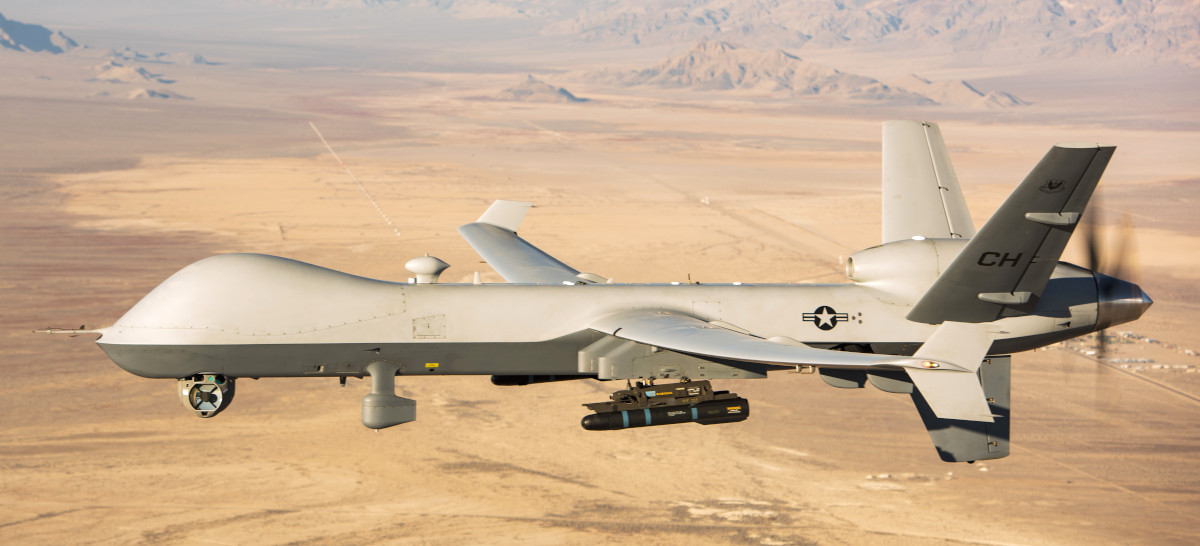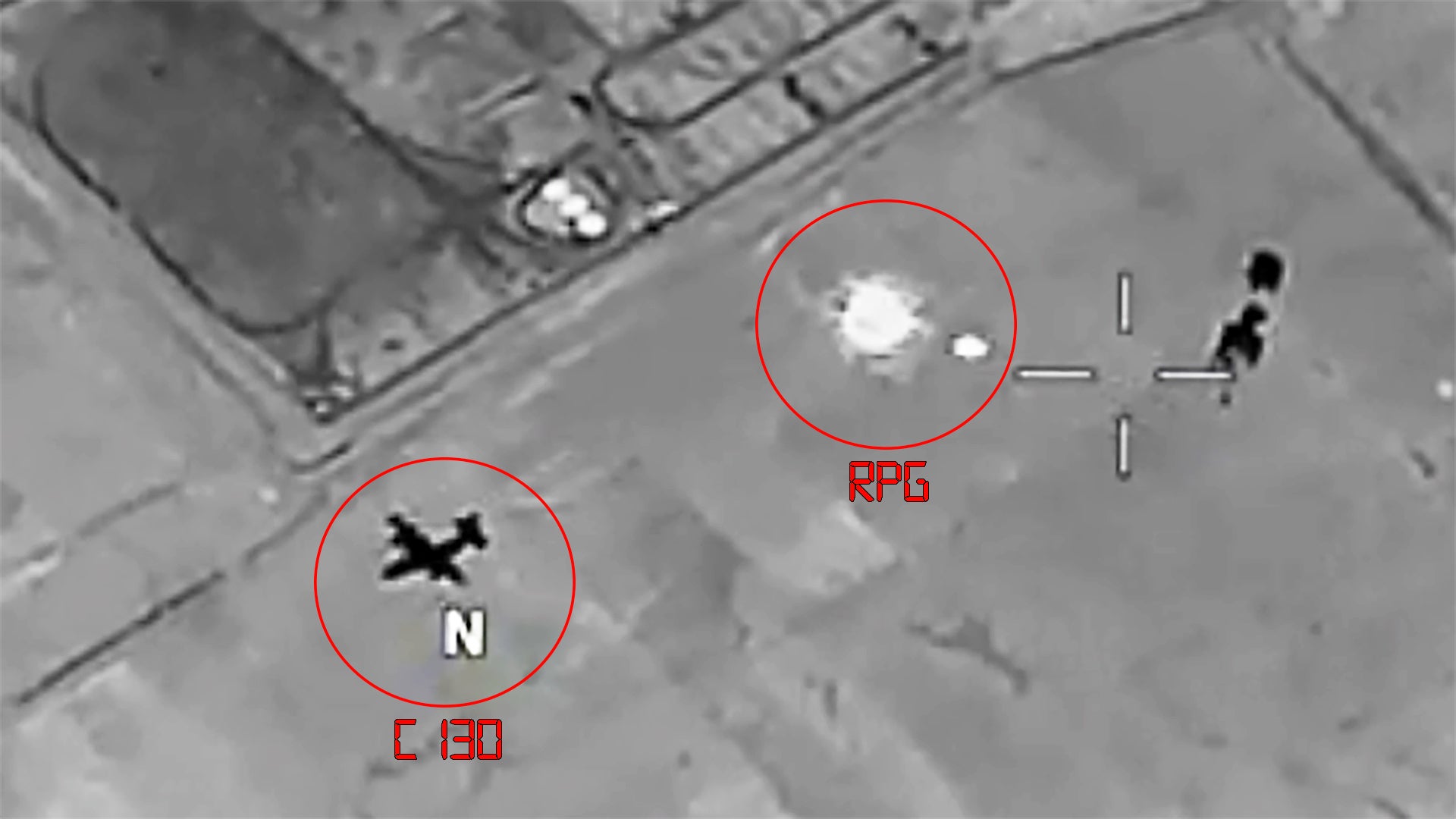The U.S. Air Force has released video that includes a unique clip that an MQ-9 Reaper captured of militants firing a rocket-propelled grenade at a C-130 Hercules airlifter that was performing an air drop of cargo at relatively low altitude. In the full video, the drone’s pilot and sensor operator, who later struck those hostile forces, also offer an interesting behind-the-scenes look at how the unmanned aircraft perform these kinds of armed overwatch missions.
The Air Force’s 432nd Wing at Creech Air Force Base in Nevada, one of the service’s premier drone units, posted the video on YouTube on Apr. 6, 2020. The pilot, 1st Lieutenant Russel, and the sensor operator, Airman First Class Ashley, both assigned to the 20th Attack Squadron, which itself is assigned to the 432nd, but is based at Whiteman Air Force Base in Missouri, describe the event. Their last names are not given for operational security reasons, though Russel’s callsign, Turret, is visible on his nametag. No information is given about the date or location of the armed overwatch mission, which could have taken place over any number of countries where the U.S. military is presently engaged overseas.
“Most of the time we’re just watching,” 1st Lieutenant Russel said. “We’re collecting information on enemies and just making sure our friendlies are safe and sometimes that involves us providing armed overwatch, which is our capability to strike enemies.”
“So, that day, we’re flying a normal eight-hour shift and then comes the end of the shift is when it all went down,” Ashley said.

Their MQ-9 was asked to provide overwatch for the C-130’s drop for “severely undersupplied” U.S. forces at a remote outpost. In the video, shot from the infrared camera in the drone’s nose-mounted sensor turret, the C-130 can be seen flying below and the cargo can be seen parachuting down behind it when a bright ball of light goes flying across the screen.
Watch a C-130H conduct a nighttime aerial resupply mission in Afghanistan in the video below.

“We immediately see from the bottom right corner of our screen a projectile come … towards the C-130,” Russel said. “The sensor immediately slewed to the right corner of origin.”
“We have screeners who work with us – they are constantly watching our feed – that helped us confirm that that’s where it was shot from,” Ashley added.
Thankfully, the RPG missed the Hercules and the cargo plane. In the video, the airlifter visibly banks to the right, but it’s unclear if that is an evasive maneuver or not.
The MQ-9 video feed then picks up a group of individuals leaving a building near the point of origin of the RPG launch. “They all left the building with large weapons,” Russel said.

“We know at that point that these are bad guys, they just shot at U.S. forces, so we know something’s about to happen. We know we need to watch these guys,” he continued. “I’m calling the Joint Terminal Attack Controller, or JTAC. I was like ‘hey, this is so-and-so in my MQ-9, we’re supporting this C-130 that did an airdrop, I just saw an RPG shoot across the screen. And his voice immediately changed.”
“He pulled up our feed, started watching it, gave us a game plan nine-line,” Ashley said. “Where he’s [the JTAC} at, he’s talking to his commander, but we are only talking to the JTAC.”
A “nine-line” refers to the brief that JTACs give to aircraft orbiting above, manned or unmanned, ahead of a close air support strike. It includes a host of relevant information, including the target and its location, the desired direction of attack to avoid hitting friendly forces or innocent bystanders, and more, in a digestible format. Being able to communicate these details rapidly and accurately is critical in these cases, where wasted seconds or miscommunication could have disastrous results.
When Ashley says that the JTAC on the ground pulled up the MQ-9’s feed, she means this literally, too. For over a decade and a half, starting with fielding of the Remotely Operated Video Enhanced Receiver (ROVER) system, the U.S. military as a whole has made major progress in developing capabilities that allow personnel on the ground to connect directly with aircraft above and see what they see what the crew sees through their electro-optical and infrared sensors. This helps speed up the process of positively identify targets during a close air support scenario, makes it easier to avoid hitting friendlies or causing collateral damage, and just improves all around situational awareness for forces on the ground and in the air.

“We found the bad guys on the ground, tracked them for a little bit, and ended up prosecuting” a strike on those militants, Ashley said. The time from the RPG went flying toward the C-130 to when MQ-9 engaged the hostile forces was 34 minutes.
The entire incident is a prime example of the kind of armed overwatch and persistent surveillance missions that Air Force MQ-9s, as well as their now-retired MQ-1 Predator predecessors, have been providing for years now, though almost exclusively in permissive environments, around the world. These are missions that U.S. Army MQ-1C Gray Eagles also now regularly perform.
“You’re hands-on, in the fight, saving our boots on the ground. This is no joke,” Ashley said in the video. “If you want to make a difference to the actual fight that’s out there, this is it.”
But the video also comes at a time when the MQ-9 may be entering the back half of its career, as the U.S. military’s focus shifts to preparing for high-end conflicts that will demand more advanced and less vulnerable platforms. In its most recent budget request for the 2021 Fiscal Year, the Air Force announced its intention to stop buying Reapers earlier than expected, which could have a number of major implications, including for the drone’s manufacturer General Atomics, which you can read about more in this past War Zone piece.
Of course, the demand for aircraft, manned and unmanned, to conduct armed overwatch missions to help protect U.S. forces, as well as their allies and partners, isn’t going away. For the foreseeable future, the Reapers will continue to provide this invaluable service for American troops around the world.
Contact the author: joe@thedrive.com
